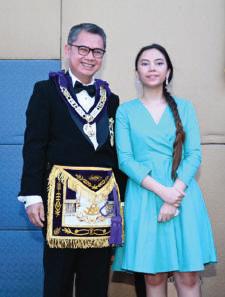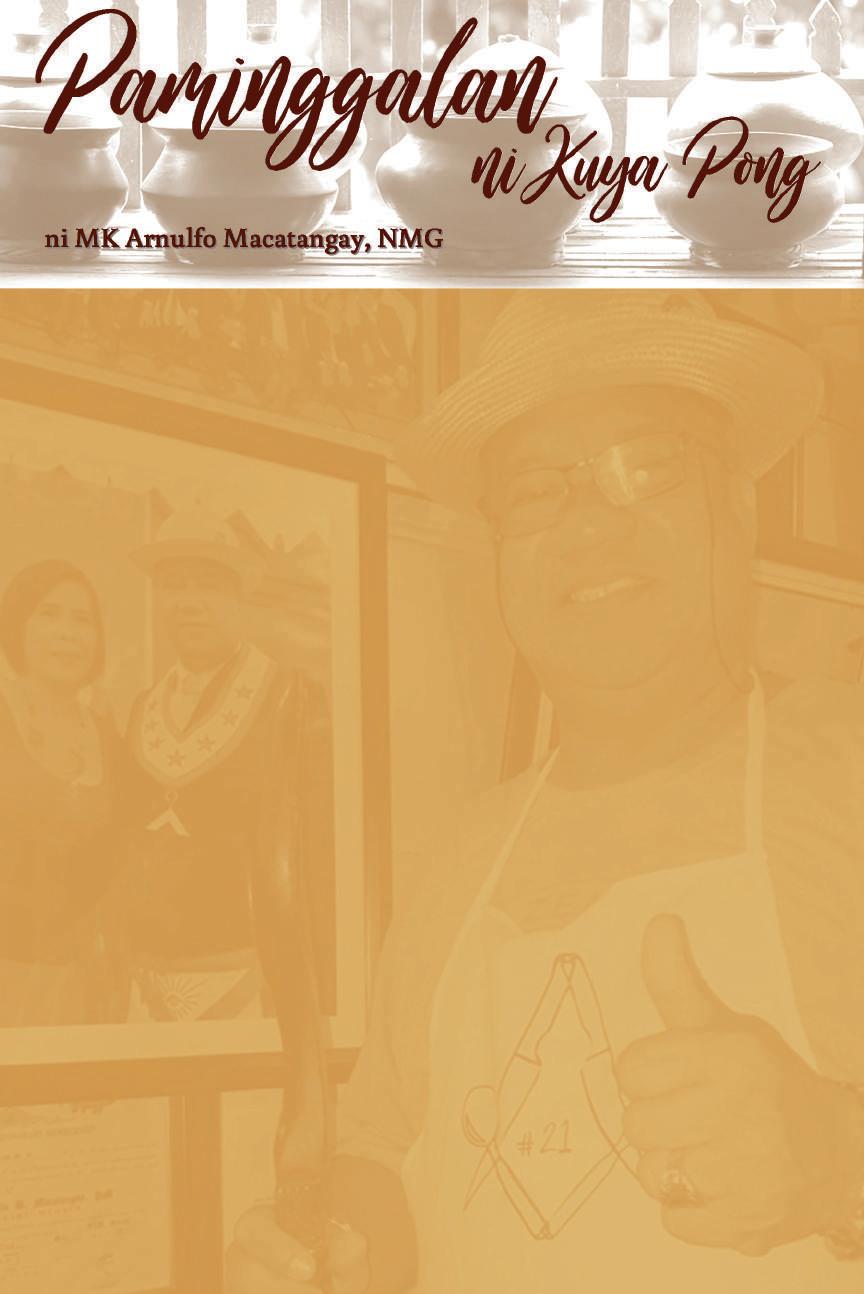6 minute read
Luzon Masonic Lodge No.57
Lusong Sulong, Sulong Luzon! - Centennial of the 57th Lodge.
By Bro. Je’an–Marie Baptiste S. Bertillo
HISTORY
Around the same time the representatives of the fifty-eight (58) member-powers of the League of Nations were pouring in the City of Lights (La Ville-Lumiere) for what was to be the league’s first executive council meeting that finally signaled its coming into existence following the effectivity of the Treaty of Versailles, several masons with minds eagerly collected and set to high purpose, also gathered albeit in a nondescript house along No. 115 Calle Villalobos, Quiapo, Manila, for the sublime prospect of laying the foundation of a new masonic lodge under the Grand Lodge of the Philippine Islands. Shortly thereafter, and capping a series of animated meetings held alternately in the home of the late esteemed Bro. Gonzalo B. Libunao in 1048 Calle Arlegui and in his dental clinic located at 3F Kneedler Building in Calle Carriedo, a petition for dispensation to form ISLA DE LUZON LODGE was signed and submitted on January 19, 1920; initially having the following thirty-one (31) Charter Members – twenty-seven (27) of whom came from Biak Na Bato Lodge, one (1) from Araw Lodge and three (3) others whose lodges from whence they came were not recorded. They were:
• Arellano, Simplicio C.S. • Bantigui, Andres M. • Bernal Leon, Julian • Bilian, Luis Lim • Buenaventura, Ponciano • Chua Heng, Faustio • De Vega, Jose A.S. • Doronilia, Vicente • Duque, Paulino • Enriquez, Eugenio • Espinosa, Jose P. • Estanislao, Jose M. • Fernandez, Apolonio B. • Filoteo, Andres • Gumila, Franciso Carag • Ladislao, Jose • Leon, Jose M.E. • Libunao, Gonzalo B. • Medina, Wenceslao • Melo, Eusebio A. • Monroy, Dalmacio V. • Moreno, Florencio • Ortiz, Carlos • Paterno, Jose P. • Ramos, Marcos • Soto Gutierrez, Lino • Velasco, Franciso • Velasco, Juan Chua • Walezykowki, John • Yalong, Emetrio C. • Zapata, Caciano G.
Awaiting the Grand Lodge’s decision on the application for dispensation, the charter members held Sunday meetings (8:00 AM-12:00 NN) at the Blue Hall (facing Pasig River) of the Masonic Temple in Escolta. On February 13, 1920 at around 12:40 PM, acting on the eager recommendations of various lodges operating in Manila, MW Rafael Palma granted the Lodge its dispensation and right then and there appointed Bro. Francisco C. Gumila as its Worshipful Master.
Nearly a year later, during the 9th Annual Communication held on January 25, 1921 at 84-96 Escolta, Manila, and on the basis of the much anticipated fiat of the Grand Lodge’s Committee on Charters, a charter was finally granted to ISLA DE LUZON LODGE NO. 57 and it was signed by MW Edwin E. Elser & Grand Secretary Newton C. Comfort. And on February 10, 1921 (8:00 PM), MW Edwin E. Elser together with the grand line officers convened at the Scottish Rite Hall, Masonic Temple in Escolta to constitute the Lodge and hold it 1st Public Installation of Officers on which occasion, the following brethren composing the lodge’s first set of officers were elected; namely:
• Worshipful Master • Senior Warden • Junior Warden • Treasurer • Secretary • Chaplain • Master of Ceremonies • Senior Deacon • Junior Deacon • Senior Steward • Junior Steward • Organist • Tyler Franciso C. Gumila Gonzalo B. Libunao Luis L. Bilian Francisco Velasco Dalmacio V. Monroy Vicente Doronilia Andres Filoteo Apolonio B. Fernandez Jose M.E. Leon Emetrio C. Yalong Paulino Duque Carlos Ortiz Marcos Ramos
Widely known as a lodge of noteworthy musicians, ISLA DE LUZON LODGE NO.57 counted among its early members the renowned musicians like the National Artist for Music, Col. Antonino Buenaventura, conductor of the Philippines Constabulary Band which after having played during the Panama Canal Exposition in the USA in 1915 was cited by no less than the king of marches – John Philip Suosa - as one of
finest military bands in the world; the eminent kundiman songs composer Nicanor Abelardo also known for having written the memorable melody of the University of the Philippines’ anthem, “U.P. Naming Mahal” as well as the highly-acclaimed “Marcha Triunfal” which he dedicated to ISLA DE LUZON in 1930 along with the equally-prized “Himno Masonico”. Other prominent members of the lodge included Paquito Villa, the manager of Francisco “Pancho Villa” Guilledo, a native of Ilog, Negros Occidental, Philippines and the first Asian ever to win the World Flyweight Championship in the U.S. in 1923, and Antonio Gonzalez, who occupied the Grand Oriental Chair in 1932 and the first Grand High Priest of the Most Excellent Grand Chapter of the Royal Arch Masons of the Philippines who, at the age of 37, became the youngest Grand Master in the country – an achievement as yet unsurpassed to this very date.
The lodge carried the name ISLA DE LUZON LODGE NO. 57 only until 1935 as the name COMMONWEALTH LODGE was adopted during the Commonwealth era. Meanwhile, with the entire country falling into enemy hands and, with the ban imposed on the operation of Masonic organizations by the Japanese military administration wary of the Brotherhood as a potential source of opposition, no lodge operation was noted from 1941 until 1944. Six (6) months after the total devastation of Manila where an estimated 100,000 to 240,000 Filipino civilians lost their lives both deliberately in the hands of the Japanese in the so-called Manila massacre and, from the artillery and aerial bombardment by both the U.S. and Japanese forces, and three (3) days prior to Japan’s formal surrender aboard the American Battleship Missouri in Tokyo Bay, Japan, Bro. Jose M. E. Leon, an active member of Nilad Lodge No. 12 at the time, summoned all surviving brethren of Commonwealth Lodge at the office of MW M. Goldenberg on August 30, 1945 to reorganize the Lodge. And, during the course of that eventful gathering, a resolution to change the lodge’s name from ISLA DE LUZON LODGE NO. 57 to LUZON LODGE NO. 57 was passed. Immediately thereafter, the Lodge resumed its operation holding regular meetings at 138 Calle Gunao, Quiapo, Manila while awaiting completion of the reconstruction of the war-damaged Plaridel Masonic Temple.
Steered by beneficent providence in proper direction, LUZON LODGE No. 57 rose from the ashes to carry the torch for those brethren who have died and to forge its own renaissance with the strongest resolve. As the years went by, while some of the brethren stayed, many in the expediency of occupation and family moved

elsewhere and for a time membership in the Lodge dwindled and its operations appeared to have likewise diminished. And yet, brushed in a radiant shimmer by the edifying character and lofty achievements of its members, the Lodge never failed to attract new worthy aspirants; thus, episodic changing of the guards became a staple that rather than weaken, worked to guarantee its own posterity. Subsequently, from a Lodge of notable musicians, it became a Lodge of highly respected uniformed men, and henceforth a Lodge of noteworthy men of different calling thereby solidifying it into one complete catalytic synergy which the LUZON LODGE NO. 57 in many quarters is renowned today.
Finally, with the lodge’s sponsorship, and the subsequent institution of, LUZON CHAPTER – ORDER OF DEMOLAY (now Luzon Chapter No. 79) on November 19, 2011, the brethren have taken a great leap forward by extending their views beyond themselves; embracing the cause of helping shape the younger versions of themselves into the leaders of tomorrow; and sharing bonds of friendship and the valuable lessons of leadership that will impact the future not only of the Lodge itself, but of FREEMASONRY on the whole.
Sources
• Book of Philippine Lodges • History of Luzon Lodge No. 57 F&AM (1953) Book c/o VW Robert C. Ocampo, PDGL PAGS Ha • Luzon Lodge No. 57 History by VW Roberto A. Palmero, PDDGM PGMar Ha • Profile of MW Antonio Gonzalez (www.grandlodge.ph) • The Cable Tow (March 1931 Issue) featuring Lodge History by VW Ramon Mendoza, PAGS • Various world & national history books













